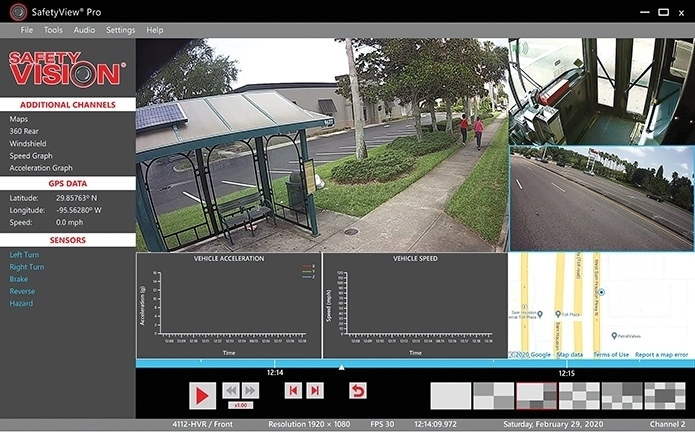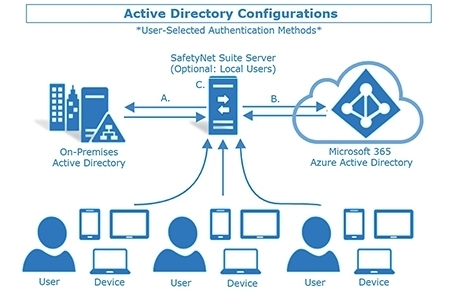
By Alicia Delgado
The age of video is at its prime. Virtual meetings, demonstrations, and even doctor appointments have heavily evolved in wake of the pandemic – and with good reason: video has become a safety net for people. However, despite the recent dependence on video technologies, one has been a constant foundation for security in the mobile world for several decades: video surveillance.
Vital to the health and well-being of the transportation industry, video surveillance provides protection to passengers, operators, and more. Beyond that, the technology that builds those systems, such as video management software (VMS) or a central management system (CMS), sets the framework for how efficient the video surveillance will be. By focusing on the user-centered design of the technology, how scalable the data storage space is, and how productively it streamlines operations; those looking for a video surveillance provider can confidently choose the system that will best support their business.

Aware of how complicated a VMS/CMS can be, many are looking for platforms that are designed with end-users in mind – meaning at first glance, the platform seems easy to navigate. While this is extremely important to factor in, user-centered design is not limited to the platform’s navigation. Ease-of-use is greatly dependent on graphic design. Further explained, the Graphics Processing Unit (GPU) in computers was specifically created for faster processing of 3D graphics. Thus, when a platform has an embellished design, the GPU uses most of its power to maintain the appearance of the VMS/CMS. After that, the computer will use other processors such as the RAM to attempt to play videos. Due to the nature of videos (an abundance of moving 3D objects), the computer will likely lack enough power to play the videos in high, nonetheless decent, quality. Therefore, when focusing on user-centered design, it is crucial to examine how simplistic the platform’s appearance is.
Additionally, storing videos requires a large amount of space. With a fleet of more than 15 buses and multiple cameras on each vehicle, the storage space would have to be expansive due to the influx of data coming in. While physical storage devices are beneficial for fleets who download a minimal amount of video data, the industry is unpredictable as some days will have events that require additional footage to be downloaded. Knowing this, it is important to have a storage space that is not only large but also scalable. The solution? The cloud. Since the cloud is a virtual server, the amount of data that can be downloaded is vast in nature and can accommodate any volume of information. Furthermore, the true beauty of the cloud is the ability for the server to adapt to any changes; as fleets increase the amount of data transferred, the cloud environment will adjust accordingly. Thus, another important factor for choosing a VMS/CMS is looking for a cloud-integrated solution.
Lastly, the intent of a VMS/CMS is to have an all-in-one system for effectively managing and simplifying fleet operations. Having a platform that visually allows users to gain a comprehensive view of their bus processes can have a major impact on improving procedures. While utilizing a VMS/CMS is an integral part of mobile surveillance, some platforms offer bonus-like features that are strategically meant for streamlining operations outside of bus/vehicle processes. So, it is critical to ask providers what additional features they have that are capable to impacting other business tasks.
Though there are many factors that determine which VMS/CMS best suits each fleet’s unique needs; some platforms are custom-designed to include the factors discussed above as an integral part of the system, rather than an accessory one. For example, Safety Vision’s new CMS SafetyNet Suite aims to enhance the entire surveillance software experience. The platform only utilizes flat graphics (similar to Windows 10 tiles) so that processing power is saved for the important part: viewing videos. It also has the option to include the SV Cloud Service so that client data is hosted, managed, and stored: saving time and money by negating the need for IT and providing a scalable space. They have also drastically reduced the effort it takes to manually input users and define their roles and permissions by offering active directory integration. Available through local on-premises servers or a Microsoft Azure connection, SafetyNet Suite automatically populates users and their roles depending on the employee system that is already in place.
At the height of mobile technology is video surveillance and it is valuable for protecting everyone involved. While implementing a system can be a daunting experience, it is key to remember that surveillance is used as a tool to aid, enhance, and reduce fleet operations, not increase them. By closely examining the characteristics and features of a VMS/CMS, those looking for a video surveillance provider can gain peace of mind that the system will positively impact their fleet.
Alicia Delgado is the Knowledge and Communications Strategist for Safety Vision, LLC. Visit www.safetyvision.com for more information.
